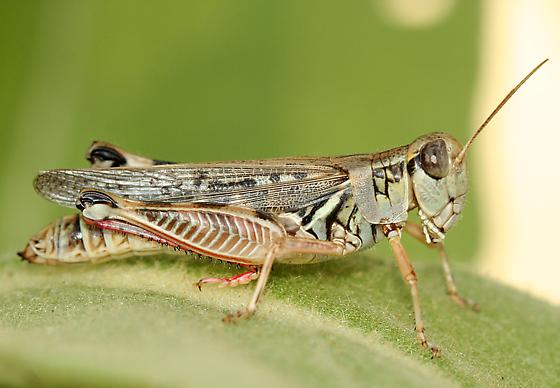
to this Large Grasshopper
Melanoplus sanguinipes
Photo#215400
Copyright © 2008 Lynette Schimming
As found on www.bugguide.net
Vast migratory swarms of flying grasshoppers, or locusts, have periodically scoured arid parts of Africa and the Middle East since Biblical times, devastating crops and causing famine. But did you know that during the 19th century, American homesteaders were likewise plagued by migratory swarms of grasshoppers? The largest swarm passed through Nebraska in June of 1875; it was 110 miles wide, 1800 miles long and more than a 1/4 mile thick, taking five days to pass overhead. It remains the world’s largest recorded insect outbreak.
Here in Utah, at the time of the transcontinental railroad, migratory locusts periodically descended on the homesteads of Mormon settlers, laying up to 1 billion eggs per acre. These ravenous swarms devoured crops, vegetation, even laundry hung out to dry. Around the Great Salt Lake, drowned pickled grasshoppers would wash ahore in vast drifts. Native peoples gathered these salty, sun-dried hoppers for food, a rich source of protein and fat.
Why are we no longer plagued by locust swarms? It appears that the Rocky Mountain locust, went extinct at the turn of the 20th century. Entomologist Jeffrey Lockwood reports that the DNA of specimens preserved in the ice of glaciers in the Wind River Range are like no other grasshopper alive today. The cause of the locust’s abrupt extinction may never be known with certainty, but Lockwood believes that these outbreaks originated in the mountain meadows of the northern Rockies. By the 1880s, these public lands were packed with cattle and sheep, far more than the land could sustain. In a few short years, livestock stripped bare the very core habitats needed by the Rocky Mountain locust, leading to its abrupt extinction and the end of locust swarms in North America.
This is Linda Kervin for Bridgerland Audubon Society.
Credits:
Photo: Courtesy & Copyright © 2008 Lynette Schimming (As found on www.bugguide.net)
Text: Jim Cane, Bridgerland Audubon Society
Additional Reading:
Locust: The Devastating Rise and Mysterious Disappearance of the Insect that Shaped the American Frontier, Jeffrey Lockwood, Basic Books, 2004,ISBN:9780738208947, https://www.amazon.com/Locust-Devastating-Mysterious-Disappearance-American/dp/0465041671 See also: https://www.jeffreylockwoodauthor.com/locust
First and annual report of the United States Entomological commission for the year 1877 relating to the Rocky Mountain locust and the best methods of preventing its injuries and of guarding against its invasions Digitized by Google Books from Harvard University
https://en.wikipedia.org/wiki/Locust
Pestiferous Ironclads: The Grasshopper Problem in Pioneer Utah, Davis Bitton and Linda P Wilcox, Utah Historical Quarterly, 46 #4 as found on “Utah History to Go” https://historytogo.utah.gov/utah_chapters/pioneers_and_cowboys/pestiferousironclads.html
